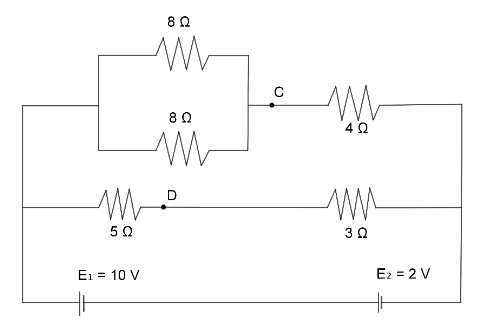Question
Question: Consider the shown circuit if each battery has zero internal resistance, then potential difference a...
Consider the shown circuit if each battery has zero internal resistance, then potential difference across point C and D is

A. 2 V
B. 3 V
C. 1.5 V
D. 4 V
Solution
We will firstly find the net potential difference of the circuit. Then, we will consider the currents through the different arms of the circuit. Then we will use the basic concepts of potential drop and potential lift. Finally, we will evaluate the potential difference between the two points.
Formulae used:
Equivalent resistance of resistances in series:
RSeries = R1 + R2 + ....... + Rn
Equivalent resistance of resistances in parallel:
RParallel1 = R11 + R21 + ...... + Rn1
Current through a circuit:
I = RV
Potential through a circuit:
V = IR
Complete step by step answer:
Since the polarity of both the cells are same thus the net potential will be the sum of the two potentials. Thus,
Eo = E1 + E2
Substituting the values, we get
Eo = 10 V + 2 V
Thus, we get
Eo = 12 V
Let us say current I be the net flowing current of the combination of the cells.And the current through the other arms be I1 and I2.
The resistances in the circuit are
R1 = 8 Ω
⇒R2 = 8 Ω
⇒R3 = 4 Ω
⇒R4 = 5 Ω
⇒R5 = 3 Ω
Now, the net resistance of the secondary circuit is,
RSec1 = R11 + R21
Substituting the value, we get
RSec1 = 81 + 81
After further evaluation, we get
RSec = 4 Ω
Then, the net resistance of the upper arm is
RUp = (4 + 4) Ω = 8 Ω
Now, the net resistance of the lower arm is,
RLow = (5 + 3) Ω = 8 Ω
Now, the value of current
I1 = RLowEo
Substituting the values, we get
I1 = 812 = 23
Thus, the potential drop across point D is,
VD = Eo − I1R4
Substituting the value, we get
